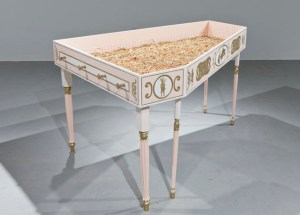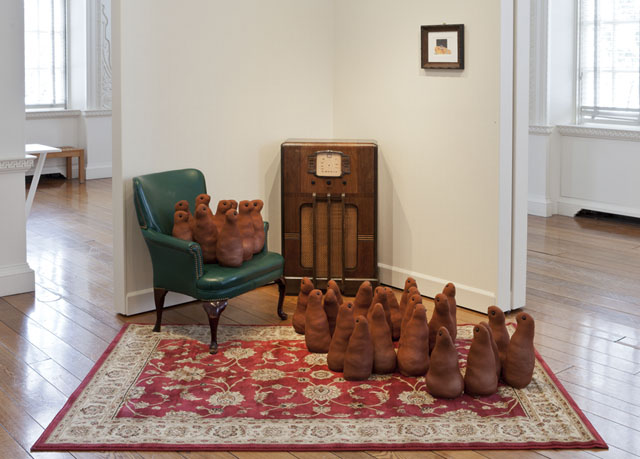Briefly describe the work you do.
I make installation-based projects that use a variety of material approaches centering around animals. I consider myself part of larger work going on in many different disciplines that strives to take animals seriously as a subject and recognizes the many complicated ways animals figure into our understanding of the world. That means that at the heart of my work are questions about how we know what we know. I use installations because they allow me to put together a lot of intersecting objects, images, and texts in ways that I hope are generative. I choose materials and forms based on the content, though my training was originally in traditional oil painting and drawing.
Tell us a little about your background and how that influences you as an artist.
The relevant background information, that is, the parts that most directly align with my work, are that I am a person who really likes learning new stuff, and likes to tell people about it. By the time I went to Iowa State University for my undergraduate degree, I had determined that my original plan of veterinary medicine wasn’t the right path because I just couldn’t get over enormous insects infesting animals, or certain kinds of lesions, and I didn’t want scrubbing for surgery to be my everyday life. I studied graphic design instead, probably because I admired the way designers communicated things in such complex yet paradoxically simple ways. Being a designer left a significant mark on what I do. And then partway through undergrad, I realized I just wanted to be really good at painting and drawing and I should at least get a second major in that. I was lucky to have a couple of colleagues who stood out as people that took art seriously, who believed it was indeed a job you could have. This was important because I think part of the reason I started down a path of graphic design was because nothing in my immediate life told me being an artist was a real option. I didn’t have many models for how to do that. But when I started to see artists who identified themselves as scholars—that made sense to me. I’ve always thought of myself as a learner, a student, and “scholar” and when I realized artists often see themselves and their work this way, it began to materialize as an option. I think the way all of that plays out in my practice is very evident.
The concept of the “artist studio” has a broad range of meanings, especially in contemporary practice. The idea of the artist toiling away alone in a room may not necessarily reflect what many artists do from day to day anymore. Describe your studio practice and how it differs from (or is the same as) traditional notions of “being in the studio.”
Something I’ve noticed over the past two years is how much the social aspects of a shared studio environment are important to me. I strongly believe everyone’s work is better when they are surrounded with opportunities for regular, informal discussion about work. The energy and support that fellow artists provide is immeasurable. I currently have my studio in what should be the living room and bedroom of my apartment, and though the easy accessibility is great, I miss going to a separate place, saying hello to people in the hallway, and calling someone in whenever I feel like it to get a quick sense of feedback or even a hand with moving something. My current studio practice, then, is not ideal and it’s a good bit more lonely and self-involved than I’d like. Part of what I love about making art is that it provides me with avenues to connect with people – ways to talk with scholars, a mode of understanding other people’s work and life. And part of why I always wanted to make things and talk about them is that I find other people who make things and talk about them interesting. So an important part of my studio practice is the reading, asking questions, thinking, and writing, and then being willing to tell people what I think through my work and continue the conversation that way.

Goat, 2012
Carved goat, glass taxidermy eyes, fabric gag, steel base (fabricated by Aaron Brunner), conceptual Drawing of Animal Conveyor System, 1987 by Temple Grandin (courtesy of the Krannert Art Museum, University of Illinois at Urbana-Champaign), fake security camera, wall text
What unique roles do you see yourself as the artist playing that you may not have envisioned yourself in when you first started making art?
I think because I am interested in professional conversations with people outside of art-making, I sometimes imagine myself as some kind of ambassador of art to other fields. I suppose I’ve always felt that way, and I think many artists do. Like if you’ve ever gone to an art museum with family and everyone wants you to explain why something is good because you’re an artist so you should know. I feel a certain responsibility to explain what we do, or at least what I do, in terms that respects our work without romanticizing it. When I go to academic conferences, its important to me to demonstrate that there are all ranges of art-making practices, and some are as rigorous and challenging as other academic disciplines, and others aren’t concerned with rigor. I guess I sometimes see myself as a translator between non-verbal, visual, expressive, or affective modes of knowing things and verbal, narrative, logic-based ways of knowing. And I’m not really even the best person to do that, but it’s something I’d like to be skilled at.
When do you find is the best time of day to make art? Do you have time set aside every day, every week or do you just work whenever you can?
I should be honest and say that the time post-graduate school is challenging in terms of a studio routine. I’ve always just worked more or less every spare block of time I’ve had. Now those times are very fractured, because I have an average of 6 jobs at any given time (some of which are creative and productive, but nevertheless they present a challenge to my energy). To me, one of the best times to make things is when I feel totally overwhelmed by something else. Like when I was teaching – I loved it, but when you get done teaching you are anxious and overly critical about everything you just said and did, and for me, running to the studio was the best thing – distracting and involved and calming even when the work wasn’t “fun”.
How has your work changed in the last five years? How is it the same?
The last 5 years included my time in graduate school at the University of Illinois at Urbana-Champaign, which means my work changed more than I can even fully appreciate. I think some of the same interests still underlie my work, but . . . when I started I was making modestly-sized paintings and chalk pastel drawings of stuffed animals. Like, bins of stuffed animals at IKEA. I actually still don’t hate that. I also used to do a lot of paintings of dogs at fairs and festivals, dogs swimming in pools. I had a feeling back then that here was something more critically interesting about dogs than was coming across in my dog paintings, but everyone read them as frivolous. I knew I wasn’t’ supposed to make art about dogs because that gets judged so quickly, but I never really shook the idea that dogs were actually important somehow. And then at the end of my second year of graduate school, I started reading a lot of animal cognition studies. It started with straight-up biology research, and then I realized there was an entire emerging discipline of people who use animals to understand the world, or who use theory to understand animals, or some messy combination of the two, and suddenly I had the critical structure from which to pursue work. This is in no small credit to the faculty at the U of I who saw the potential for criticality in my work and knew where to direct me. And it also grew from a lucky coincidence that an animal studies initiative was happening on campus that brought visiting scholars and offered an excellent special topics course. The content of the work deepened, broadened, and got richer for me at the same time as a major shift in materials and structure.
Are there people such as family, friends, writers, philosophers or even pop icons that have had an impact on the work you do?
I was lucky to have an excellent cohort of fellow graduate students who were dedicated, critical, and invested in one another and their own progress, but not competitive or jealous. These people’s energy and direction, and their willingness to admit failures or doubts, helped to make art-making a dynamic, engaged practice for me that has everything to do with a shared community focused on success. It helped that my surroundings are people who are far less concerned the commercial or “art world” successes and more concerned with using art to satisfy their curiosity and engagement with the world.
It will probably sound cliché because David Foster Wallace influences so many people, but there is a lot about his voice and sense of humor and irony and observation that stands as an incredible example of what one might strive for. I’m talking in particular about his non-fiction. Creative non-fiction in general serves as a template for me in a lot of ways – its this method of learning about a subject, trying to teach someone else what you’ve learned, impressing that learning with your own voice and view, and still leaving room for other ideas to emerge from the mess of words and paragraphs. My art-making is an excuse for me to learn as much as I can about things, and then to translate or share that in the most interesting way I can.
If you had an occupation outside of being an artist, what would that be and why?
I feel lucky that being an artist basically lets me be all the other jobs I’d want. I could see myself being a scholar and teacher in an animal-studies related field, though I have a lot of academic-type training to catch up on since I didn’t do that sort of research as an undergrad or grad student. But I can be involved I those discussions as an artist, because thankfully the field seems generous and open and willing to listen to someone who’s forms of validation are very different than traditional forms of validating knowledge. I have a degree in graphic design and as much as I would not want to design for others full time, I get to be a designer constantly in my own studio practice. I am incredibly grateful for that training. I think I would also probably like to be a writer. My approach to writing (non-fiction) feels very similar to my approach to making visual work, so I think I would satisfy a lot of the things that art-making does for me. And I love teaching. I would most definitely teach. I’d teach something, and ideally, I’d teach art.
About
 Maria Lux holds an MFA in painting/sculpture from the University of Illinois at Urbana-Champaign and BFAs in graphic design and studio art from Iowa State University in Ames, Iowa. She currently lives and works in Champaign.
Maria Lux holds an MFA in painting/sculpture from the University of Illinois at Urbana-Champaign and BFAs in graphic design and studio art from Iowa State University in Ames, Iowa. She currently lives and works in Champaign.
All images copyright of the artist and used with their permission.


